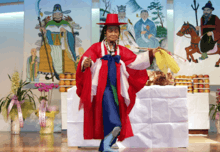Korean shamanism
| Part of a series on |
| Korean shamanism |
|---|
 |
|
Sub-movements |
|
Related religions |
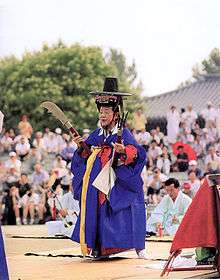
Korean shamanism, also known as Shinism[note 1] (Hangul 신교, Hanja 神敎; Shingyo or Shinkyo, "religion of the spirits/gods"),[1][2] or Shindo (Hangul: 신도; Hanja: 神道, "way of the spirits/gods"),[3][4] is the collective term for the ethnic religions of Korea which date back to prehistory,[5] and consist in the worship of gods (신 shin) and ancestors (조상 josang).[4] When referring specifically to the shamanic practice (Hangul: 무속, Hanja: 巫俗; musog or musok), the term Muism (Hangul:무교, Hanja: 巫敎; Mugyo or Mukyo, "religion of the mu [shamans]") is used.[6][7]
The general word for "shaman" in Korean language is mu (Hangul: 무, Hanja: 巫).[5] In contemporary terminology, they are called mudang (무당, 巫堂) if female or baksu if male, although other terms are used locally.[6][note 2] The Korean word mu is synonymous of the Chinese word wu 巫, which defines both male and female shamans.[10] The role of the mudang is to act as intermediary between the spirits or gods and humanity in order to solve hitches in the development of life, through the practice of gut rituals.[11]
Central to Korean shamanism is the belief in a supreme God and supreme mind, Haneullim or Hwanin, meaning "source [im, in] of all being [haneul, hwan]" and of all gods of nature,[12] The mu are described as descendants of the "Heavenly King", son of the "Holy Mother", with the investiture passing down through female lineage.[13] Other myths relate the shamans to Dangun, male son of the Heavenly King and founder of the Korean nation.[14]
Muism is related to Chinese Wuism,[15] Japanese Shinto, and to the Siberian, Mongolian, and Manchurian shamanic traditions.[15] According to some scholars, the Korean ancestral god Dangun is related to the north Asian supreme Tengri ("Heaven"), which is the force embodied by both the shaman and the prince.[16][17] Hereditary shamans, who are typical of South Korea, are called tangur or tangol (당골),[8] or tangur-ari, a word considered related to the Siberian Tengri.[18] Mudang are similar to Japanese miko and Ryukyuan yuta. Korean shamanism has influenced some Korean new religions, such as Cheondoism and Jeungsanism, and some Christian churches in Korea make use of practices rooted in shamanism.[19]
Terminology
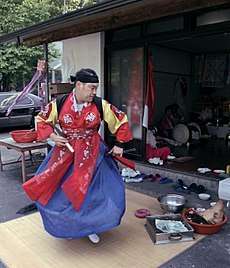
Names of the religion
Besides "Shinism" and "Muism", other terms used to define Korean shamanism include Goshindo (고신도, 古神道; "way of the ancestral gods"), used in the context of the new religious movement of Daejongism,[20] and Pungwoldo (風月道, "way of brightness"), used by the Confucian scholar Choe Chiwon between the 9th and the 10th century.[21] Shamanic associations in modern South Korea use the terms Shindo or Mushindo (무신도 "shamanic way of the spirits") to define their congregations or membership, and musogin ("people who do shamanism") to define the shamans.[4]
Names of the shamans
The Korean word 무 mu is related to the Chinese 巫 wu,[22] which defines shamans of either sex, and likely also to the Mongol/Altaic "Bo" and Tibetan "Bon". Korean shamanic terminology has, however, at least a partial origin in Siberian languages. Already in records from the Yi dynasty, mudang has a prevalent usage.[23] Mudang itself is explained in relation to Chinese characters, as originally referring to the "hall", 堂 tang, of a shaman.[23] A different etymology, however, explains mudang as stemming directly from the Siberian term for female shamans, utagan or utakan.[23]
Mudang is used mostly, but not exclusively, for female shamans.[23] Male shamans are called by a variety of names, including sana mudang (literally "male mudang") in the Seoul area, or baksu mudang, also shortened baksu ("doctor", "healer"), in the Pyongyang area.[23] According to some scholars, baksu is an ancient authentic designation of male shamans, and locutions like sana mudang or baksu mudang are recent coinages due to the prevalence of female shamans in recent centuries.[9] Baksu may be a Korean adaptation of terms loaned from Siberian languages, such as baksi, balsi or bahsih.[6]
The theory of a Siberian origin of Korean shamanic terminology is more reasonable than theories which explain such terminology as originating in Chinese,[6] given that Chinese culture influenced Korea only at a relatively recent stage of Korean history.[6] Likely, when Koreans adopted Chinese characters they filtered their previously oral religious culture through the sieve of Chinese culture.[6]
Types and roles of shamans
Hereditary and initiated mu
Korean shamans may be classified into two categories:[24] ❶ sessǔmu or tangol (당골),[8] people who are shamans and have the right to perform rites by family lineage; and ❷ kangshinmu, people who become shamans through an initiation ceremony. Hereditary shamans were historically concentrated in the southern part of the Korean peninsula, while initiated shamans were found throughout the entire peninsula but were peculiar to the northern half, the contiguous areas of China inhabited by Koreans, and the central regions along the Han River.[24]
The work of the mu is based on the holistic model, which takes into consideration, not only the whole person, but the individual's interaction with his environment, thus both the inner and outer world. The soul is considered the source of life breath, and any physical illness is considered to be inextricably linked with sickness of the soul. Illness of the mind has its cause in soul loss, intrusion or possession by malevolent spirits. The gut rites practised by Korean shamans, have gone through a number of changes since the Silla and Goryeo periods. Even during the Joseon dynasty, which established Korean Confucianism as the state religion, shamanic rites persisted. In the past, such rites included agricultural rites, such as prayers for abundant harvest. With a shift away from agriculture in modern Korea, agricultural rites have largely been lost and modern-day shamans are more focused on the spiritual issues of urban life.
"Self-loss" and "divine wind" experiences
People who become shamans are believed to be "chosen" by the gods through a spiritual experience known as shinbyeong ("divine illness"), a form of ecstasy, which entails the possession from a god and a "self-loss". This state is said to manifest in symptoms of physical pain and psychosis. Believers assert that the physical and mental symptoms are not subject to medical treatment, but are healed only when the possessed accepts a full communion with the spirit.[25]
The illness is characterised by a loss of appetite, insomnia, visual and auditory hallucinations. The possessed then undergoes the naerim-gut, a ritual which serves both to heal the sickness and to formally establish the person as a shaman.[26]
Korean shamans also experience shinmyeong ("divine wind"), which is the channelling of a god, during which the shaman speaks prophetically.[27] Shinmyeong is also experienced by entire communities during the gut hold by the shaman, and is a moment of energisation which relieves from social pressure, both physical and mental.[28]
Myths about the origin of the shamans
In all the myths which figuratively explain the role of the shamans, it is implied that they are media, intermediaries, of higher forms of being.[29] They are not ordained institutionally, but receive ordination from Heaven itself.[29] The supreme God, "King of Heaven"—Haneullim or Hwanin—has a key role in all the myths regarding the shamans.[29]
Generally, these myths explain that shamans, whom in the most recent history of Korea are regarded as belonging to the lowest class of society (cheonmin 천민), have a forgotten divine or princely nature,[30] often coming from a blood lineage that may be traced back to the early founders of civilisation.[30] Further features of these myths are symbols of divine presence, such as the holy mountain and the holy tree,[31] and tragic or painful experiences.[32]
The bear is an animal often present in such myths, with parallels in the mythologies of Siberia.[33] In such Siberian traditions, in the Chinese tradition of the Yellow Emperor and other divine progenitors, and in Korean shamanism as well, the bear is a symbol of the Big Dipper (i.e. Ursa Major), itself a symbol of the supreme God.[34] In Korean shamanism the seven stars of the Big Dipper, and the associated divine influence, are considered fundamental for childbearing.[35]
Sungmo—the Holy Mother

In a collection of myths, the origin of the shamans is linked to a mother goddess associated with a mountain and presented as either the mother or the spiritual daughter of the "Heavenly King". She has different names according to different regions and associated mountains: Sungmo ("Holy Mother"), Daemo ("Great Mother"), Jamo ("Benevolent Mother"), Sinmo ("Divine Mother"), Nogo ("Olden Maiden"), and others.[36] In other myths she is a mortal princess who is later turned into a goddess.
These myths usually tell of a man, Pobu Hwasang, who encountered the "Holy Mother [of the Heavenly King]" on the top of a mountain.[37] The Holy Mother then became a human being and married the man who met her, giving birth to eight girls, the first mudang.[37] According to some scholars, this myth was first elaborated in the Silla period, when Buddhism and influences from China had already penetrated the Korean peninsula.[38]
The myth of the princess is the most popular, and it differs from region to region.[39] In one of the versions, the princess is Ahwang Kongju of the Yao kingdom, located on the Asian mainland.[39] The princess had a strong link with divinity, granting welfare to her people.[39] Her father sent the princess among the people, whom began to worship her for her healing powers.[40] The first mudang were established as her successors.[40] The princess is worshipped with seasonal offerings in Chungcheong.[40] The yellow and red clothes worn by the mudang are regarded as Ahwang Kongju's robes.[40]
In the north of the Korean peninsula the princess is known as Chil Kongju (the "Seventh Princess"), seventh amongst the daughters of the king.[40] The myth tells that she was rejected by her father, who sealed her in a stone coffin and casted it in a pond, but she was rescued by a Dragon King sent by the Heavenly King, and ascended to the western sky becoming the goddess of healing waters.[40] Names of the goddess in other local traditions Pali Kongju and Kongsim.[40] In the tradition of Jeju Island, where there are more male baksu than female mudang, the myth tells of a prince as the ancestor of all shamans.[41]
Dangun—the Sandalwood King
Dangun is traditionally considered to be the son of Hwanin, the "Heavenly King", and founder of the Korean nation.[14] This myth is reputed to be older than that of the mother goddess.[14] Myths similar to that of Dangun are found in Ainu[33] and Siberian cultures.[15]
The myth starts with prince Hwanung ("Heavenly Prince"), son of Hwanin. The prince asked his father to grant him governance over Korea.[42] Hwanin accepted, and Hwanung was sent to Earth bearing three Heavenly Seals and accompanied by three thousand followers.[42] The prince arrived under the holy tree of sandalwood (Sintansu 신단수, 神檀樹)[43] on the holy mountain, where he founded his holy city.[42]
At the time of his reign, Ungnyeo or Ungnye (웅녀, 熊女)[43]—who was a she-bear—and a tiger were living in a cave near the holy city, praying earnestly that their wish to become part of mankind might be fulfilled.[42] Ungnyeo patiently endured weariness and hunger, and after twenty-one days she was transformed into a beautiful woman, while the tiger ran away for it could not tolerate the effort.[42] The woman Ungnyeo was overjoyed, and visiting the sandalwood city she prayed that she might become the mother of a child.[42]
Ungnye's wish was fulfilled, so that she became the queen and gave birth to a prince who was given the royal name of Dangun, the "Sandalwood King".[42] Dangun reigned as the first human king of Korea, giving to his kingdom the name of Joseon, "Land of the Morning Calm".[42]
Dangun was the first shaman, intermediary between mankind and Haneullim, to whom he worshipped and prayed on the behalf of his people.[44] The importance of the worship of ancestors and gods reside in their being the mean of communion with the supreme God, Haneullim.[44] According to some scholars, the name Dangun is related to the Siberian Tengri ("Heaven"),[17] while the bear is a symbol of the Big Dipper (Ursa Major).[34] Later in the myth, Dangun becomes the Sansin, the "Mountain God" (metaphorically of civilising growth, prosperity).[45]
Theology
Haneullim
Haneullim or Haneulnim ("Heavenly King"), also spelled Hananim or Hanunim, Hwanin or Hanin, also called Sangje ("Highest Deity") or Sangjenim ("Kingly Highest Deity"), also known simply Haneul ("Heaven") or Cheon ("Heaven", in Sino-Korean), or Cheonsin ("God of Heaven"), is the supreme God of Korean shamanism.[18] Haneullim is etymologically explained as meaning "progenitor [im, in] of all being [haneul, hwan]", indicating the absolute, supreme mind.[18]
This belief is unquestionable for the shamans, and they view their workings as coming from him.[18] According to scholars, the belief in this supreme God is at the heart of all religions in Korea, being deeply rooted in the mind of the Korean people.[18]
Threefold conception of divinity
Korean theology has a triune idea of God expressed in the myth of Dangun, the third and fully incarnated form of Hwanin.[18] With Dangun as Sansin ("Mountain God"), the divine trinity of Korean religion represents the three stages of Haneullim's manifesation.[18] Hwanin represents the transcendent source, with "haneul", "hwan" indicating "all being" or "Heaven", and "im", "in" the cause of it.[18] Hwanung, the second hypostasis of Hwanin, is the god of the middle realm, between Heaven and Earth.[18]
Dangun, the "Sandalwood King", is the god of the Earth.[18] In the role of Sansin, he represents the axle of the world around which all things spin and which links up to Heaven.[46] In the place where Heaven incarnated, the "holy mountain" of civilisation was established, and the sandalwood became the "holy tree". The symbols of the cosmic mountain and tree are common to all shamanic experiences, as highlighted by Mircea Eliade in his studies.[31]
In the Korean tradition, the threefold conception of divinity is also explained in terms of: God-the-Father, creator of the universe (Hwanin); God-the-Teacher, the order of nature (Hwanung); and God-the-King, the supreme God incarnated by the human king (Dangun), who governs his kingdom according to the laws of nature, granting well-being to his citizens.[47]
Practices
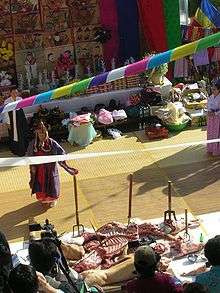
Gut rites
The gut or kut are the rites performed by Korean shamans, involving offerings a sacrifices to gods and ancestors.[48] They are characterised by rhythmic movements, songs, oracles and prayers.[49] These rites are meant to create welfare, promoting commitment between the spirits and mankind.[48] The major categories of rites are the naerim-gut, the dodang-gut and the ssitgim-gut.
Through song and dance, the shaman begs the gods to intervene in the fortune of men. The shaman wears a very colourful costume and normally speaks in ecstasy. During a rite, the shaman changes his or her costume several times. Rituals consist of various phases, called gori.[50]
The gut is meant as a crossroads where three participants met: The gods, the believers, and the shamans who mediate between them. The communion between spirits and mankind is believed to take place through a cup of purified wine, called bokjan or "cup of blessings".[51] There are different types of gut, which vary from region to region. The procedure and style of these rites largely depends on the purpose of the ceremony, and on the character and abilities of the performing shaman. However, the rites generally show threefld structures—for instance, dances and songs repeated three times.[51] Threefold repetition has an important symbolic meaning in Korean shamanism, being considered the best way to complete an action.[51] Its meaning is grounded in the theological conception of the threefoldness of God—Hwanin, Hwanung, Dangun—, the three stages of manifestation of Haneullim.[52]
Purification
Purity of both the body and the mind is a state that is required for taking part in rituals.[51] Purification is considered necessary for an efficacious communion between living people and ancestral forms.[51] Before any gut is performed, the altar is always purified by fire and water, as part of the first gori of the ritual itself.[51] The colour white, extensively used in rituals, is regarded as a symbol of purity.[51] The purification of the body is performed by burning white paper.[51]
History
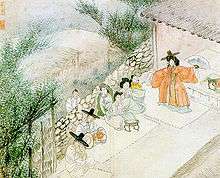
Korean shamanism goes back to prehistoric times, pre-dating the introduction of Buddhism and Confucianism, and the influence of Taoism, in Korea.[15] It is similar to Chinese Wuism.[15] Vestiges of temples dedicated to the utmost Haneullim. as well as to other gods, have been found on tops and slopes of many mountains in the peninsula.[15]
Although many Koreans converted to Buddhism when it was introduced to the peninsula in the 4th century, and adopted as the state religion in Silla and Goryeo, it remained a minor religion compared to Korean shamanism.[53]
Since the 15th century, in the state of Joseon, things changed with the adoption of Neo-Confucianism as the state religion.[54] Non-Confucian religions were suppressed and Korean shamanism started to be regarded as a backward relic of the past.[54] In the late 19th and 20th century, a series of circumstances, namely the influence of Christian missionaries and the disruption of society caused by modernisation, contributed to a further weakening of Korean shamanism, ultimately paving the way for a significant growth of Christianity.[55][53]
In the 1890s, when the Joseon dynasty was collapsing, Protestant missionaries gained significant influence through the press, leading a demonisation of Korean traditional religion and even campaigns of violent suppression of local cults.[56] Protestant demonisation would have had a long-lasting influence on all subsequent movements which promoted a complete elimination of Korean shamanism.[56]
During the Japanese rule over Korea, the Japanese tried to incorporate Korean shamanism within, or replace it with, State Shinto.[57][58] For a short period in the 1940s, however, after the defeat of the Japanese, Korean shamanism was identified as the pure Korean national essence.[59]
The situation of Korean shamanism worsened after the division of Korea and the establishment of a northern Socialist government and a southern pro-Christian government.[60] South Korean anti-superstition policies in the 1970s and 80s forbade traditional religion and wiped out all ancestral shrines.[61] These policies were particularly tough under the rule of Park Chung-hee.[58] In North Korea, all shamans and their families were targeted as members of the "hostile class" and were considered to have bad songbun, "tainted blood".[62]
In recent decades, Korean shamanism has experienced a resurgence in South Korea,[63] while in North Korea, accordng to demographic analyses, approximately 16% of the population practises some form of traditional ethnic religion or shamanism.[64]
Branchings
Since the early 19th century, a number of movements of revitalisation or innovation of traditional Korean shamanism arose. They are characterised by an organised structure, a codified doctrine, and often a holy scripture. They may be grouped into three major families: ❶ the family of Daejongism or Dangunism, ❷ the Donghak-originated movements (including Cheondoism and Suunism), and ❸ the family of Jeungsanism (including Jeungsando, Daesun Jinrihoe, the now-extinct Bocheonism, and many other sects).[65]
Temples
Historically, Korean shamanism and traditional religion relied upon a system of ancestral shrines, sadang (사당), similar to those found in China and Japan. Larger temples are called myo (literally "temple") or gung (literally "palace"). Korean shamanic temples may be distinguished by their use of taegeuk (태극) and manja (만자) symbolism, and some of them have gates similar to Japanese Shinto torii.
Almost all traditional shrines were destroyed in the 19th and 20th century during Christian waves of persecution and the governments' campaigns for "modernisation". In recent years there have been cases of reconstruction of shrines and resumption of rites in some villages.[66]
See also
| Wikimedia Commons has media related to Shamanism of Korea. |
Footnotes
- ↑ Superscript H in "Shinism" and "Shindo" means that the terms may be spelled either "Shinism" and "Shindo" or "Sinism" and "Sindo", with no difference.
- ↑ Other terms include tangol or tangur (당골; used in southern Korea for hereditary shamans), and mansin (used in central Korea, the Seoul area, and northern Korea).[8] The word mudang is mostly associated, though not exclusively, to female shamans due to their prevalence in recent history. This prevalence of women has led to the development of new locutions to refer to male shamans, including sana mudang (literally "male mudang") in the Seoul area or baksu mudang ("healer mudang"), shortened baksu, in the Pyongyang area. It is reasonable to believe that the word baksu is an ancient authentic designation for male shamans.[9]
References
- ↑ Korean Cultural Service (1998), p. 33.
- ↑ Yunesŭk'o Han'guk Wiwŏnhoe (1985), p. 22.
- ↑ Korean Cultural Service (1992), p. 27.
- 1 2 3 Kendall (2010), p. x.
- 1 2 "무교". Educational Terminology Dictionary (in Korean). 29 June 1995. Retrieved 2018-03-22.
- 1 2 3 4 5 6 Lee (1981), p. 4.
- ↑ Kim (1998).
- 1 2 3 Kendall (2010), p. ix.
- 1 2 Lee (1981), pp. 3–4.
- ↑ Lee (1981), p. 5.
- ↑ Choi (2006), p. 21.
- ↑ Lee (1981), pp. 5, 17–18.
- ↑ Lee (1981), pp. 5–12.
- 1 2 3 Lee (1981), p. 13.
- 1 2 3 4 5 6 Lee (1981), p. 21.
- ↑ Sorensen (1995), pp. 19–20.
- 1 2 Lee (1981), pp. 17–18.
- 1 2 3 4 5 6 7 8 9 10 Lee (1981), p. 18.
- ↑ Kim, Andrew E. (1 July 2000). "Korean Religious Culture and Its Affinity to Christianity: The Rise of Protestant Christianity in South Korea" (PDF). Sociology of Religion. 61 (2). pp. 117–133. doi:10.2307/3712281.
- ↑ Lee (2010s), p. 12.
- ↑ Lee (2010s), p. 14.
- ↑ Lee (1981), pp. 3–5.
- 1 2 3 4 5 Lee (1981), p. 3.
- 1 2 Kim (1998), pp. 32–33.
- ↑ Kim (1998), pp. 41–42.
- ↑ Kim (1998), pp. 42–43.
- ↑ Kim (2005), pp. 9–10, note 10.
- ↑ Kim (2005), pp. 53–54.
- 1 2 3 Lee (1981), p. 10.
- 1 2 Lee (1981), p. 11.
- 1 2 Lee (1981), p. 19.
- ↑ Lee (1981), pp. 11–12.
- 1 2 Lee (1981), p. 20.
- 1 2 Didier (2009), passim but especially Vol. I, pp. 143, 154.
- ↑ Korean Cultural Service (1998), p. 34.
- ↑ Lee (2010s), pp. 6–7.
- 1 2 Lee (1981), pp. 5–6.
- ↑ Lee (1981), pp. 5–6, 13.
- 1 2 3 Lee (1981), p. 6.
- 1 2 3 4 5 6 7 Lee (1981), p. 7.
- ↑ Lee (1981), p. 12.
- 1 2 3 4 5 6 7 8 Lee (1981), p. 14.
- 1 2 Lee (2010s), pp. 10–13.
- 1 2 Lee (1981), p. 17.
- ↑ Lee (1981), pp. 16–18.
- ↑ Lee (1981), pp. 18–19.
- ↑ Lee (2010s), pp. 13–14.
- 1 2 Lee (1981), p. 27.
- ↑ Lee (1981), p. 40.
- ↑ Lee (1981), p. 31.
- 1 2 3 4 5 6 7 8 Lee (1981), p. 38.
- ↑ Lee (1981), p. 39.
- 1 2 Pyong Gap Min (2010). Preserving Ethnicity Through Religion in America: Korean Protestants and Indian Hindus Across Generations. New York University Press. ISBN 081479615X. p. 44.
- 1 2 Choi (2006), p. 15.
- ↑ Kim, Andrew E. (October 2001). "Political Insecurity, Social Chaos, Religious Void and the Rise of Protestantism in Late Nineteenth-Century Korea". Social History. 26 (3). pp. 267–281. JSTOR 4286798.
- 1 2 Kendall (2010), pp. 4–7.
- ↑ Sorensen (1995), pp. 11–22.
- 1 2 Choi (2006), p. 17.
- ↑ Sorensen (1995), p. 23.
- ↑ Sorensen (1995), pp. 24–27.
- ↑ Kendall (2010), p. 10.
- ↑ Demick, Barbara (2009). Nothing to Envy: Ordinary Lives in North Korea. Spiegel & Grau. ISBN 0385523904.
- ↑ Choi (2006), pp. 17–19.
- ↑ "Country Profile: Korea, North (Democratic Peoples Republic of Korea)". Religious Intelligence UK. Archived from the original on 13 October 2007.
- ↑ Lee (2010s), passim.
- ↑ Kwon, Heonik (15 June 2009). "Healing the Wounds of War: New Ancestral Shrines in Korea" (PDF). The Asia-Pacific Journal. 7 (24/4).
Bibliography
- Choi, Joon-sik (2006). Folk-Religion: The Customs in Korea. Ewha Womans University Press. ISBN 8973006282.
- Didier, John C. (2009). "In and Outside the Square: The Sky and the Power of Belief in Ancient China and the World, c. 4500 BC – AD 200". Sino-Platonic Papers. Victor H. Mair (192). Volume I: The Ancient Eurasian World and the Celestial Pivot, Volume II: Representations and Identities of High Powers in Neolithic and Bronze China, Volume III: Terrestrial and Celestial Transformations in Zhou and Early-Imperial China.
- Kim, Hae-Kyung Serena (2005). Sciamanesimo e Chiesa in Corea: per un processo di evangelizzazione inculturata (in Italian). Gregorian Biblical BookShop. ISBN 8878390259.
- Kim, Tae-kon (1998). Korean Shamanism—Muism. Jimoondang Publishing Company. ISBN 898809509X.
- Kendall, Laurel (2010). Shamans, Nostalgias, and the IMF: South Korean Popular Religion in Motion. University of Hawaii Press. ISBN 0824833988.
- Korean Cultural Service (1998). "Korean Culture" (19).
- Korean Cultural Service (1992). "Korean Culture" (12–13).
- Lee, Chi-ran (2010s). "The Emergence of National Religions in Korea" (PDF). Archived from the original (PDF) on 13 April 2014.
- Lee, Jung Young (1981). Korean Shamanistic Rituals. Mouton De Gruyter. ISBN 9027933782.
- Sorensen, Clark W. (July 1995). The Political Message of Folklore in South Korea's Student Demonstrations of the Eighties: An Approach to the Analysis of Political Theater. Fifty Years of Korean Independence. Seoul, Korea: Korean Political Science Association.
- Yunesŭk'o Han'guk Wiwŏnhoe (1985). "Korea Journal". Korean National Commission for UNESCO.
